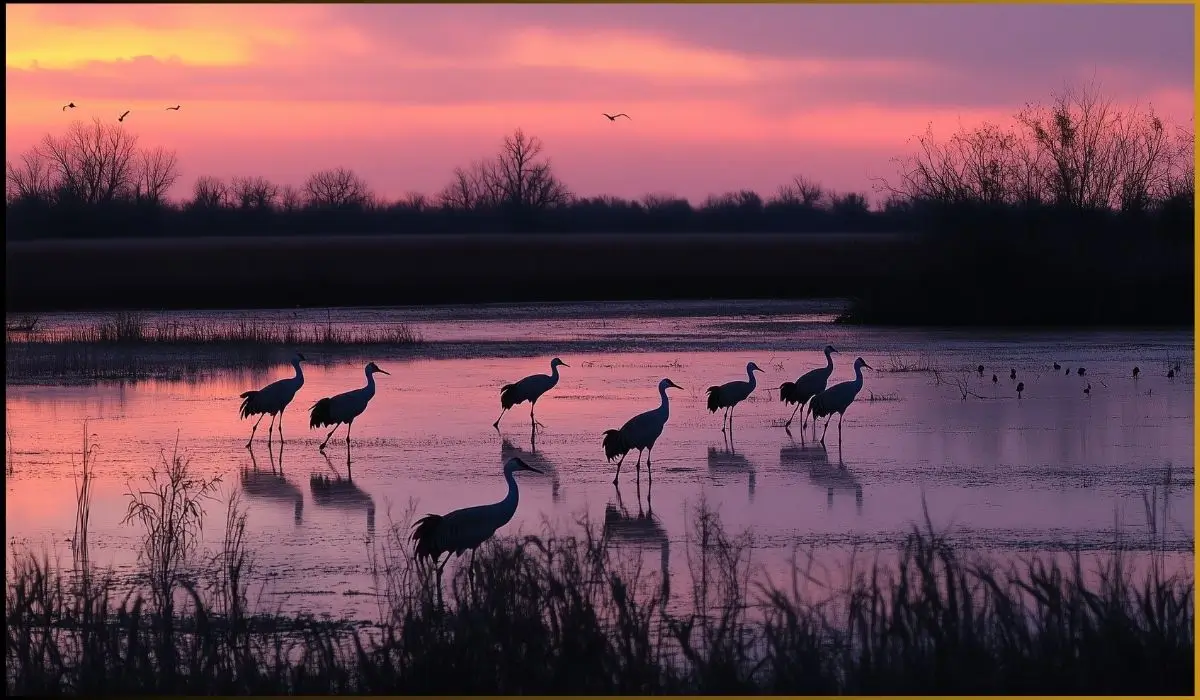
Michigan’s ecosystems provide a haven for two amazing crane species: the Sandhill Crane and the rare Whooping Crane.
In this blog post, we will discover the 2 types of cranes in Michigan. All the information was collected from the Michigan Gov. Website.
Types of Cranes in Michigan
There are only 2 types of cranes found in Michigan, including Sandhill Cranes and Whooping Cranes.
- Sandhill Cranes
- Whooping Cranes
Let’s explore their habitat, diet, location, the best time to see, etc.
1. Sandhill Cranes in Michigan
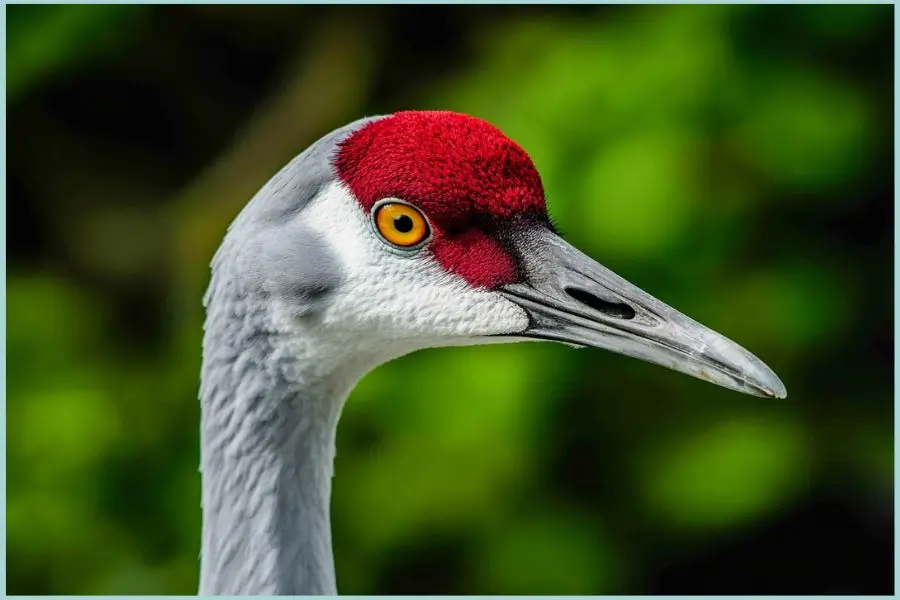
Sandhill Cranes are relatively common in Michigan and can be found throughout the state.
Key Facts:
- Size: Up to 5 feet tall with a 6-foot wingspan
- Diet: Omnivorous, feeding on seeds, grains, insects, and small animals
- Habitat: Wetlands, marshes, and agricultural fields
An ornithologist at Michigan State University, notes, “Sandhill Cranes have shown remarkable adaptability in Michigan. Their population has rebounded significantly over the past decades, thanks to conservation efforts and their ability to thrive in both natural and human-altered landscapes.”
They can often be seen in fields and wetlands, where they feed on plants, insects, and small animals.
| Diet | Seeds, grains, insects, small animals including snakes, frogs |
| Habitat | Wetlands, marshes, bogs, agriculture areas, roadsides, swamps, grassy areas near wetlands |
| Best places to see | Bernard W.Baker Sanctuary Haehnle Sanctuary Kensington Metropark Waterloo Recreation Area |
Related: White Birds in Michigan
Best Places to See Sandhill Cranes in Michigan
- Bernard W. Baker Sanctuary:
- Location: Bellevue, MI
- Best viewing times: Dawn and dusk during fall migration (September-November)
- Visit the sanctuary website
- Haehnle Sanctuary:
- Location: Pleasant Lake, MI
- Known for large crane gatherings during migration
- Sanctuary information
- Kensington Metropark:
- Location: Milford, MI
- Year-round crane viewing opportunities
- Park details
- Seney National Wildlife Refuge:
- Location: Upper Peninsula
- Summer breeding grounds for Sandhill Cranes
- Refuge website
Sandhill cranes can be seen in many wetland areas in Michigan, including wildlife refuges and state parks.
Some good places to see them include the Seney National Wildlife Refuge, the Shiawassee National Wildlife Refuge, and the Allegan State Game Area.
Best Time to See:
According to Michigan Audubon, the best time to see them to prior 10 a.m. and after 2 p.m.
Here are the best times to see sandhill cranes:
- Spring: March to April (migration)
- Fall: September to November (migration)
- Summer: Breeding season
Tip: Visit before 10 AM or after 2 PM for best viewing.
They can also be seen in Michigan during the summer months when they are breeding and raising their young.
Fun Facts:
- Sandhill cranes are large grey birds with long necks and legs.
- They are known for their distinctive calls, which can be heard from long distances.
- Sandhill cranes mate for life and can live up to 20 years in the wild.
- They eat a variety of foods, including seeds, grains, insects, and small animals like frogs and snakes.
- They can often be seen foraging in fields and wetlands.
Related: Blue Birds in Michigan
2. Whooping Cranes in Michigan (Endangered Species)
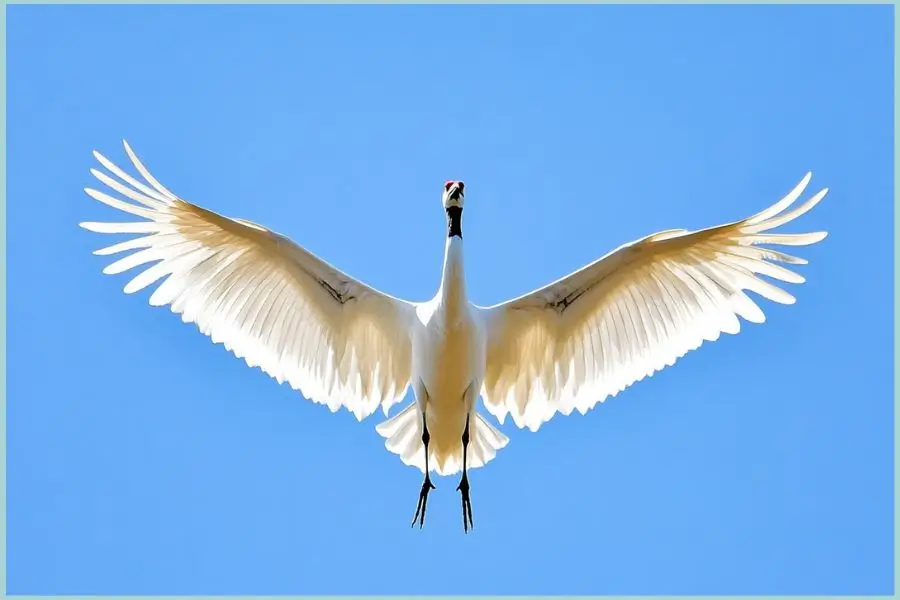
Whooping cranes are an endangered species of bird that can be found in Michigan during their migration between their breeding grounds in Canada and their wintering grounds in Texas.
“Whooping Crane sightings in Michigan are incredibly rare and exciting events,” says John Doe, a wildlife biologist with the Michigan Department of Natural Resources. “These sightings are crucial for tracking their migration patterns and overall population health.”
Whooping Cranes Diet, Habitat and Size:
| Diet | Small animals like insects, fish, and small mammals, as well as plants and seeds |
| Habitat | Wetlands like marshes, swamps, and bogs |
| Size | Over 5.5 feet tall with a wingspan of up to 7 feet |
They are tall, white birds with black wingtips and a bright red patch on their heads.
Where to See Them in Michigan?
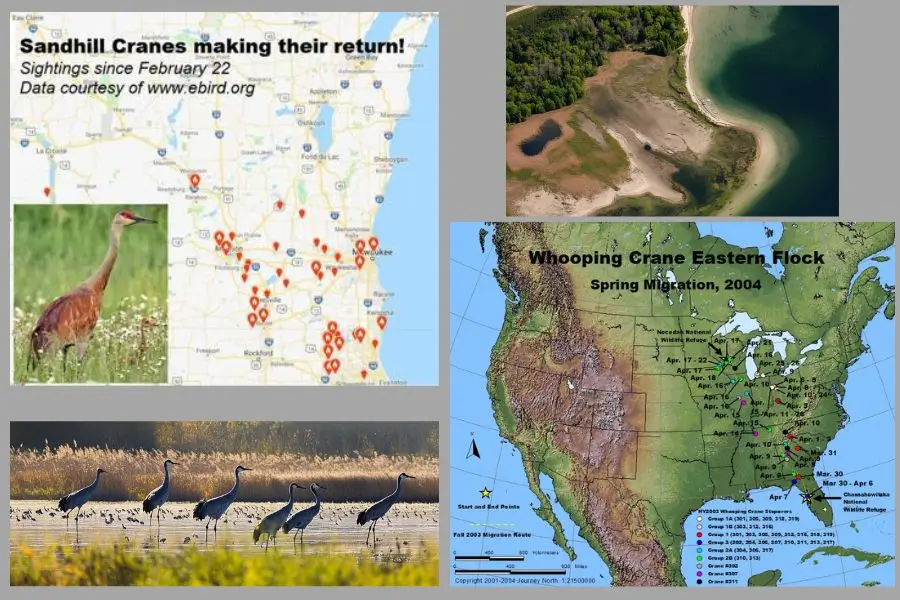
The best places to see whooping cranes in Michigan are in the Upper Peninsula at the Seney National Wildlife Refuge and the Hiawatha National Forest.
In Michigan, whooping cranes can sometimes be seen in the fall and spring.
Whooping cranes are one of the tallest birds in North America.
Related: Doves in Michigan
Whooping Crane Conservation
The International Crane Foundation leads efforts to protect Whooping Cranes. Their work includes:
- Habitat restoration
- Captive breeding programs
- Migration route protection
Learn more about Whooping Crane conservation
Crane Photography Tips
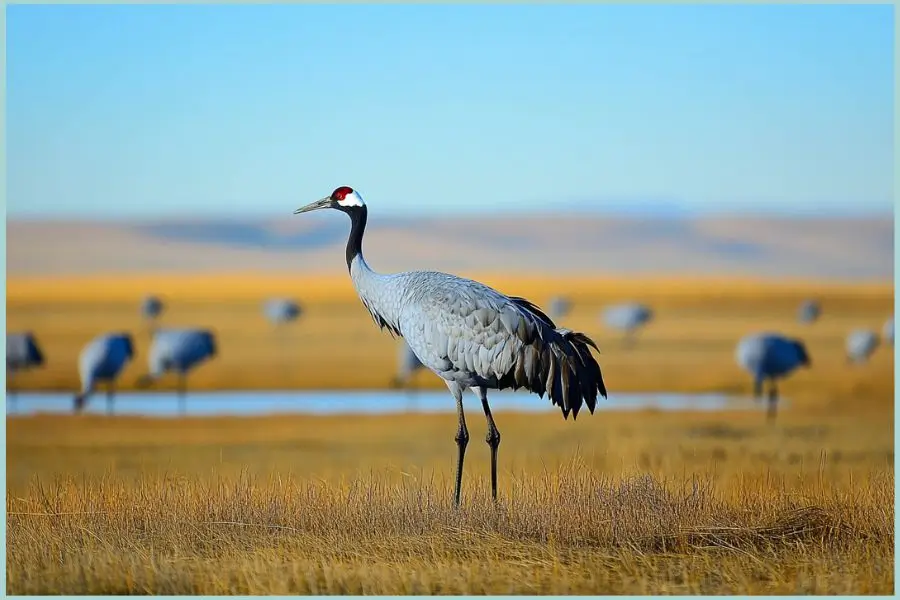
Capturing images of cranes can be a rewarding experience. Here are some tips from professional wildlife photographer Jane Smith:
- Use a long lens (at least 400mm) to avoid disturbing the birds.
- Visit known crane hotspots during golden hour for the best light.
- Be patient and respect the birds’ space.
- Consider using a blind or your vehicle as a hide.
Crane Viewing Etiquette
To ensure the safety and well-being of cranes:
- Maintain a safe distance (at least 100 yards)
- Use binoculars or spotting scopes for close-up views
- Never feed or attempt to touch the birds
- Keep noise to a minimum
Crane Behavior and Life Cycle
Cranes have fascinating behaviors. Let’s explore:
Mating Rituals
- Perform elaborate dances
- Make loud, distinctive calls
- Form lifelong pair bonds
Nesting Habits
- Build nests in shallow water
- Use plant materials for construction
- Both parents care for eggs and chicks
Migration Patterns
- Travel long distances seasonally
- Follow specific flyways
- Return to same breeding and wintering grounds
Cranes in Michigan: Threats and Conservation Efforts
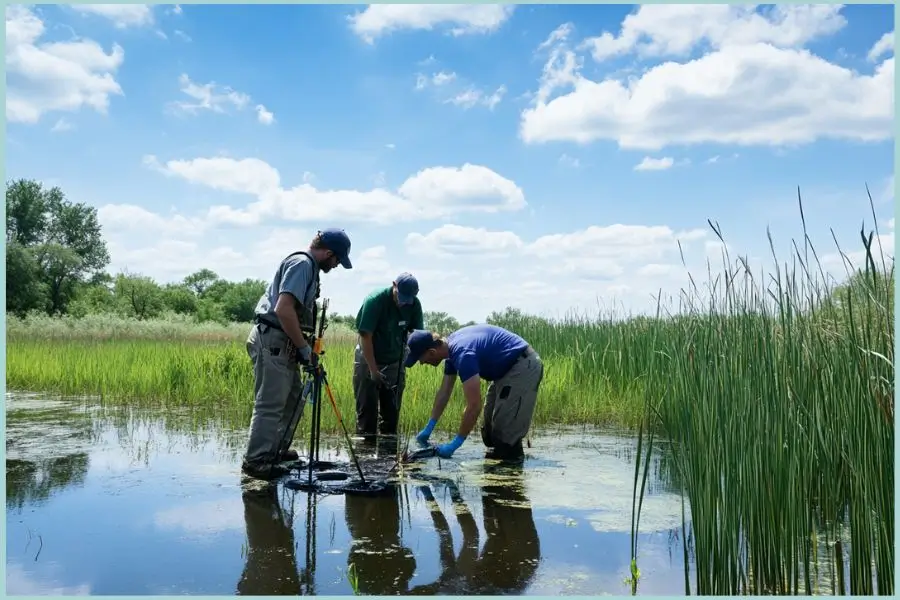
Let’s delve into the threats faced by Sandhill Cranes and Whooping Cranes in Michigan and the vital conservation efforts aimed at protecting these magnificent birds.
1. Threats:
#Habitat Loss:
A major threat to Michigan’s cranes is habitat loss. It comes from urban development, agriculture, and wetland drainage.
These birds nest and forage in wetlands and grasslands. So, habitat destruction harms their populations.
#Pollution
Pollution, particularly water pollution from agricultural runoff and industrial activities, threatens cranes.
Contaminated water sources can harm their food supply and nesting areas.
#Climate Change
Climate change is altering the landscapes cranes depend on.
It can disrupt their migration, nesting sites, and food availability. This makes it hard for cranes to adapt.
2. Conservation Efforts:
#Habitat Restoration
Several groups, including the Michigan Department of Natural Resources and local conservationists, are restoring wetlands and grasslands.
These efforts aim to create and protect habitats for cranes and other wildlife.
#Protected Areas
Protected areas and wildlife refuges, like Michigan’s Shiawassee National Wildlife Refuge, provide safe havens for cranes.
These areas offer undisturbed nesting and foraging sites.
#Education and Outreach
Groups like the International Crane Foundation and the Michigan Audubon Society run programs to raise awareness of crane conservation.
These programs promote responsible land use practices and advocate for policies that protect cranes.
#Research and Monitoring
Ongoing research helps scientists better understand crane populations and their needs.
By tracking their movements and studying their behavior, researchers can create better conservation strategies.
#Policy Advocacy
Policies from various organizations protect crane habitats and limit harmful activities.
They ensure land-use planning and development consider cranes and other wildlife.
#Collaborative Initiatives
The U.S. Fish and Wildlife Service protects cranes. It works with state agencies, non-profits, and international partners.
The Whooping Crane Recovery Plan aims to restore an endangered species.
#Climate Change
To fight climate change and its effects on cranes, we urge a cut in greenhouse gas emissions.
We also support initiatives that help cranes adapt to changing environments.
People Also Ask:
You can find all the questions answered regarding “Cranes in Michigan” that people ask on Google. Here are the questions and answers:
-
1. Are cranes common in Michigan?
Sandhill cranes are relatively common in Michigan, particularly in wetland areas where they prefer to live. On the other hand, Whooping cranes are very rare in Michigan and are only seen during their migration in the fall and spring.
-
2. What birds in Michigan look like cranes?
There are a few birds in Michigan that resemble cranes, although they are not cranes. Here are a few examples: Great Blue Herons, Sandpipers, Egrets
-
3. What is the biggest crane in Michigan?
The biggest crane in Michigan is the Whooping crane. Whooping cranes are one of the tallest birds in North America, standing over five feet tall with a wingspan of up to seven feet.
-
4. Are whooping cranes in Michigan?
Yes, Whooping cranes are occasionally found in Michigan during their migration in the fall and spring. However, they are very rare in Michigan and are considered an endangered species.
-
5. Where do cranes in Michigan go in the winter?
The Sandhill cranes that live in Michigan typically migrate south to spend the winter in warmer climates, such as Florida, Texas, and Mexico. They generally leave Michigan in October or November and return in February or March.
-
6. Can you hunt cranes in Michigan?
No, it is illegal to hunt cranes in Michigan. Both Sandhill cranes and Whooping cranes are protected by state and federal laws.
-
Are cranes legal to hunt in Michigan?
No, hunting cranes is illegal in Michigan. Both Sandhill and Whooping Cranes are protected under state and federal laws.
-
How can I tell the difference between a Sandhill Crane and a Great Blue Heron?
Sandhill Cranes have a red crown and fly with their necks outstretched, while Great Blue Herons tuck their necks in flight.
-
Do cranes migrate from Michigan in winter?
Yes, most Sandhill Cranes migrate south for the winter, typically to Florida, Texas, or Mexico. They return to Michigan in late February or early March.
Conclusion:
In Conclusion, Michigan’s Cranes are very beautiful and rare. Michigan has two types of cranes, the Sandhill crane and the endangered Whooping crane. Sandhill cranes are found in many wetland areas in Michigan and are known for their unique calls.
Whooping cranes are much rarer and can sometimes be seen during their migration in the fall and spring. They are tall, white birds with distinctive calls and are one of the tallest birds in North America.
Conservation efforts are helping to protect the whooping crane population, but they are still endangered.
This guide was created with input from ornithologists, wildlife biologists, and local birdwatching experts. For the most up-to-date information on crane populations and viewing opportunities in Michigan, please consult the Michigan Audubon Society or the Michigan Department of Natural Resources.

